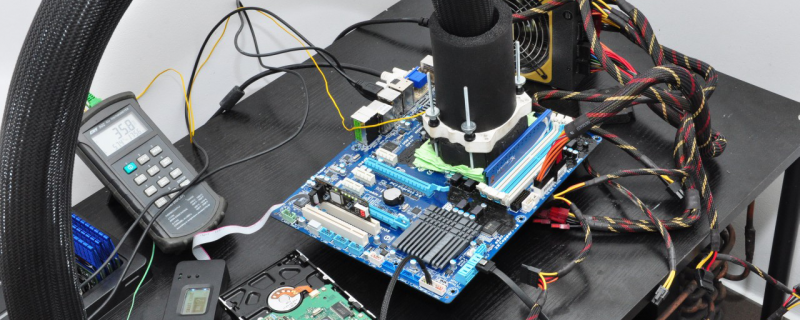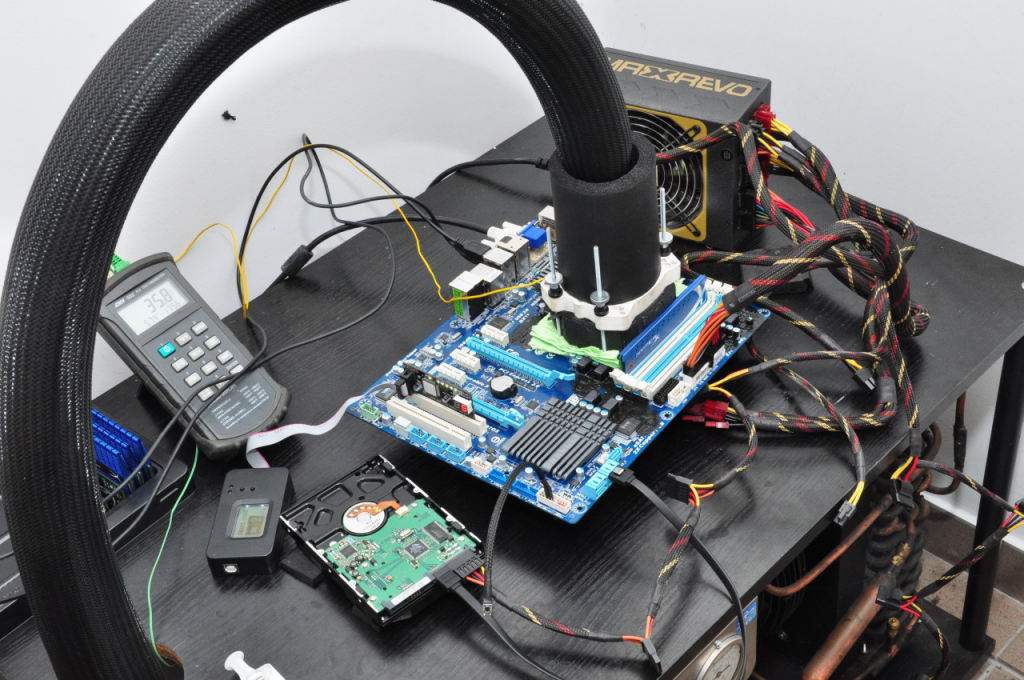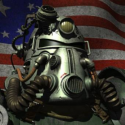
The first part of the article focused on liquid nitrogen, which has a boiling point of -196 degrees Celsius. This time round I’m going to tell you about a slightly less extreme cooling method.
Phase-change
This method is based on the same principle as air conditioning or refrigeration.
- When gas condenses to liquid it releases heat (in a condenser)
- When liquid evaporates to gas it absorbs heat (in an evaporator)
This process occurs in a permanent cycle.
Here’s a very basic overview of the process:
and here’s one that’s a bit more detailed
When it comes to cooling your PC, the main principle is the same. What’s different is what is cooled. In a refrigerator, of course, the evaporator has a large surface, but in a PC the cooling is handled by a rather small copper plate that could be attached to the top of the CPU, the GPU or the northbridge. Whole units are usually custom-built to suit the needs of the overclocker.
There are ready solutions on the market, but personally I recommend getting a custom phase-change cooler. That said, be sure you pick somebody with solid experience and whom you can trust to do the job.
We can distinguish two kinds of phase change cooling: Single stage (commonly called SS) and cascade.
Single stage is done with a compressor and enables temperatures down to ca. -50 C to be achieved.
Cascade has two compressors, so it is way more advanced and requires considerable skill to be crafted properly. In a nutshell, the first compressor’s loop cools the CPU or GPU like in the single stage unit, but there is a second compressor loop that cools the first loop. This makes it possible to achieve temperatures down to -100 C.
 Schematics for cascade cooling; for PC usage, the evaporator would take a different form and the temperatures it achieved would be lower
Schematics for cascade cooling; for PC usage, the evaporator would take a different form and the temperatures it achieved would be lower
Some of you may now be thinking about a triple-stage cascade. Due to the limitations of physics, such a unit would be rather ineffective. The benefits over a unit with two compressors would be very small. And even dual-stage cooling is very big, hard to assemble, loud, expensive and power hungry.
There is also something in between cascade and SS – autocascade.
This unit has but a single compressor, but it is much more complex than a standard single stage. On the other hand, it requires only one compressor to be built. And this is one of the most expensive parts of the whole system. Autocascade is capable of achieving temperatures down to around -75 degrees C, making it a reasonable compromise between single stage and cascade in terms of both cost and temperature.
Good to know: the performance of phase change units greatly depends on the gas the system uses. And, as you can imagine, there isn’t a one-size-fits-all solution. You have to know which gas is most suitable for which uses, both in terms of raw performance and price-to-performance ratio.
One of biggest downsides of phase-change cooling is that the control temperatures can’t be controlled. While there are ways of gaining control, none of them is without its faults. In an optimal unit, there are only two states: power on and power off, and temperatures are constant. The only way to regulate temperatures in a very limited range is to slightly loosen or tighten the evaporator on the cooled component (tighter contact improves heat transfer and reduces temperatures while looser contact worsens heat transfer and raises temperatures).
Summary
Phase-change cooling is very good for overclocking older and less powerful hardware. Ancient CPUs like the AMD K6 could run some benchmarks for over 5 hours. You cool such hardware with SS, start the benchmark and do something else. When you come back, the result is there. Using liquid nitrogen, however, would be bothersome and expensive. Cooling a chip that generates even a marginal amount of heat for five hours would require a disproportionately large amount of nitrogen.
Phase-change cooling is also a very good choice for beginner overclockers. After you power it up you don’t have to worry about pouring liquid nitrogen and keeping temperature at optimal level. It just works and keeps temperatures stable as long as it is plugged in to your power source.
There is also much less water condensation compared to LN2 cooling, thanks to obviously a significantly smaller temperature difference between the ambient temperature and -50 degrees Celsius than between ambient and -196 degrees.
Finally, a question: is SS suitable for daily usage? The noise it throws off and the need to wait to power on the PC for it to work can be inconvenient. Then again, I encountered someone who used cascade on a daily basis, but that is even less convenient.
The upsides:
- Low cost of usage – you only pay for electricity
- Maintains cooled hardware at stable temperatures
- Easy to use: once you switch it on, you can concentrate on tweaking
- Appropriate for daily usage
- No additional equipment needed (pots or dewars)
- Good for hardware that requires many hours of benching
- Water condensation is not such an issue
The downsides:
- Heavy and bulky
- Putting together a unit requires a lot of experience
- Expensive
- Very loud
- The temperatures achieved are way too high for some hardware to be pushed to the limit
- Temperatures could be too low for some hardware to operate it (coldbug)
- No optimal way to control temperatures
Water chiller
This method is very similar to single-stage phase change cooling. A single compressor unit evaporator cools liquid in a watercooling loop thanks to a heat exchanger. The main difference is the lowest temperature that can be achieved. It is very hard to go below -20 C with a waterchiller. And even for such temperatures, special water pumps and a non-standard coolant must be used.
The main advantage of a waterchiller over standard-phase change cooling is that hardware temperatures are easy to control. With the appropriate controller, you just set the temperature you desire (eg -5 C) and it will be maintained.
You can also cool more than one piece of hardware using this method—simply plug more waterblocks into the loop. If you choose to do that, know that quick release fittings (QDC) are convenient as you plug in just the blocks that you want. Remember, though, that coolant in subzero conditions gets really dense, so too many overly restrictive blocks and QDC fittings will kill the flow.
For obvious reasons, Cascade has no appliance in this case, because the coolant would become a solid in such low temperatures.
The water chiller method is an excellent way of cooling hardware that have such coldbug, that single stage is too cold for it. It is also even better for daily usage than SS because it produces less condensation.
The upsides:
- Low cost of usage – you only pay for electricity
- Maintains cooled hardware at stable temperatures
- Easy to use: once you switch it on, you can concentrate on tweaking
- Appropriate for daily usage
- No additional equipment needed
- Good for hardware that requires many hours of benching
- Temperatures can be controlled
- Water condensation is not such an issue
The downsides:
- Heavy and bulky
- Putting together a unit requires a lot of experience
- Expensive
- Very loud
- The temperatures achieved are way too high for some hardware to be pushed to the limit
Read: Extreme cooling – part III























